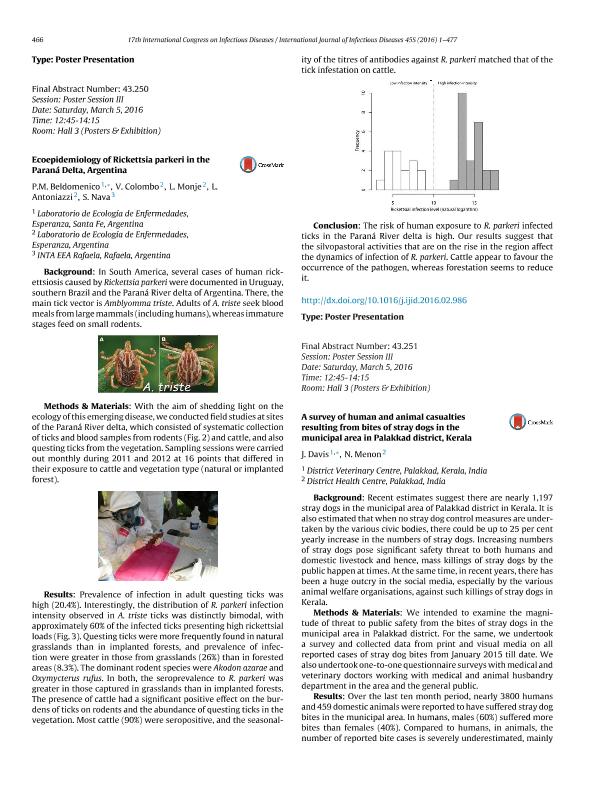Mostrar el registro sencillo del ítem
dc.contributor.author
Beldomenico, Pablo Martín

dc.contributor.author
Colombo, V.
dc.contributor.author
Monje, Lucas Daniel

dc.contributor.author
Antoniazzi, Leandro Raúl

dc.contributor.author
Nava, Santiago

dc.date.available
2021-12-14T10:34:27Z
dc.date.issued
2016
dc.identifier.citation
Ecoepidemiology of Rickettsia parkeri in the Paraná Delta, Argentina; 17th International Congress on Infectious Diseases; Hyderabad; India; 2016; 1-1
dc.identifier.issn
1201-9712
dc.identifier.uri
http://hdl.handle.net/11336/148678
dc.description.abstract
Background: In South America, several cases of human rickettsiosis caused by Rickettsia parkeri were documented in Uruguay, southern Brazil and the Paraná River delta of Argentina. There, the main tick vector is Amblyomma triste. Adults of A. triste seek blood meals from large mammals (including humans), whereas immature stages feed on small rodents.Methods & Materials: With the aim of shedding light on the ecology of this emerging disease, we conducted field studies at sites of the Paraná River delta, which consisted of systematic collection of ticks and blood samples from rodents (Fig. 2) and cattle, and also questing ticks from the vegetation. Sampling sessions were carried out monthly during 2011 and 2012 at 16 points that differed in their exposure to cattle and vegetation type (natural or implanted forest).Results: Prevalence of infection in adult questing ticks was high (20.4%). Interestingly, the distribution of R. parkeri infection intensity observed in A. triste ticks was distinctly bimodal, with approximately 60% of the infected ticks presenting high rickettsial loads (Fig. 3). Questing ticks were more frequently found in natural grasslands than in implanted forests, and prevalence of infection were greater in those from grasslands (26%) than in forested areas (8.3%). The dominant rodent species were Akodon azarae and Oxymycterus rufus. In both, the seroprevalence to R. parkeri was greater in those captured in grasslands than in implanted forests. The presence of cattle had a significant positive effect on the burdens of ticks on rodents and the abundance of questing ticks in the vegetation. Most cattle (90%) were seropositive, and the seasonality of the titres of antibodies against R. parkeri matched that of the tick infestation on cattle.Conclusion: The risk of human exposure to R. parkeri infected ticks in the Paraná River delta is high. Our results suggest that the silvopastoral activities that are on the rise in the region affect the dynamics of infection of R. parkeri. Cattle appear to favour the occurrence of the pathogen, whereas forestation seems to reduce it.
dc.format
application/pdf
dc.language.iso
eng
dc.publisher
Elsevier

dc.rights
info:eu-repo/semantics/openAccess
dc.rights.uri
https://creativecommons.org/licenses/by-nc-nd/2.5/ar/
dc.subject
ECOEPIDEMIOLOGIA
dc.subject
RICKETTSIA PARKERI
dc.subject
DELTA DEL PARANA
dc.subject.classification
Otras Ciencias Veterinarias

dc.subject.classification
Ciencias Veterinarias

dc.subject.classification
CIENCIAS AGRÍCOLAS

dc.title
Ecoepidemiology of Rickettsia parkeri in the Paraná Delta, Argentina
dc.type
info:eu-repo/semantics/publishedVersion
dc.type
info:eu-repo/semantics/conferenceObject
dc.type
info:ar-repo/semantics/documento de conferencia
dc.date.updated
2021-07-05T16:39:59Z
dc.journal.volume
45
dc.journal.pagination
1-1
dc.journal.pais
Países Bajos

dc.journal.ciudad
Amsterdam
dc.description.fil
Fil: Beldomenico, Pablo Martín. Consejo Nacional de Investigaciones Científicas y Técnicas. Centro Científico Tecnológico Conicet - Santa Fe. Instituto de Ciencias Veterinarias del Litoral. Universidad Nacional del Litoral. Facultad de Ciencias Veterinarias. Instituto de Ciencias Veterinarias del Litoral; Argentina
dc.description.fil
Fil: Colombo, V.. No especifíca;
dc.description.fil
Fil: Monje, Lucas Daniel. Consejo Nacional de Investigaciones Científicas y Técnicas. Centro Científico Tecnológico Conicet - Santa Fe. Instituto de Ciencias Veterinarias del Litoral. Universidad Nacional del Litoral. Facultad de Ciencias Veterinarias. Instituto de Ciencias Veterinarias del Litoral; Argentina
dc.description.fil
Fil: Antoniazzi, Leandro Raúl. Consejo Nacional de Investigaciones Científicas y Técnicas. Centro Científico Tecnológico Conicet - Santa Fe. Instituto de Ciencias Veterinarias del Litoral. Universidad Nacional del Litoral. Facultad de Ciencias Veterinarias. Instituto de Ciencias Veterinarias del Litoral; Argentina
dc.description.fil
Fil: Nava, Santiago. Instituto Nacional de Tecnología Agropecuaria. Centro Regional Santa Fe. Estación Experimental Agropecuaria Rafaela; Argentina. Consejo Nacional de Investigaciones Científicas y Técnicas. Centro Científico Tecnológico Conicet - Santa Fe; Argentina
dc.relation.alternativeid
info:eu-repo/semantics/altIdentifier/url/http://www.sciencedirect.com/science/article/pii/S1201971216309651
dc.conicet.rol
Autor

dc.conicet.rol
Autor

dc.conicet.rol
Autor

dc.conicet.rol
Autor

dc.conicet.rol
Autor

dc.coverage
Internacional
dc.type.subtype
Congreso
dc.description.nombreEvento
17th International Congress on Infectious Diseases
dc.date.evento
2016-03
dc.description.ciudadEvento
Hyderabad
dc.description.paisEvento
India

dc.type.publicacion
Journal
dc.description.institucionOrganizadora
International Society for Infectious Diseases
dc.source.revista
International Journal of Infectious Diseases

dc.type
Congreso
Archivos asociados
